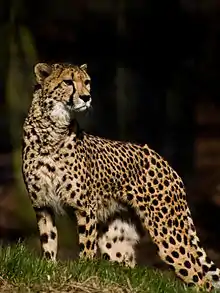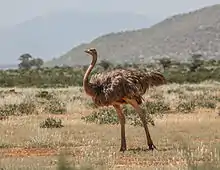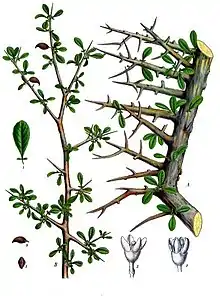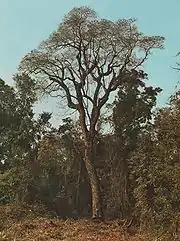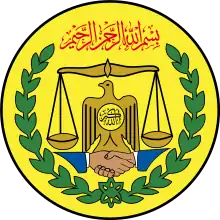Wildlife of Somaliland
The wildlife of SomaliLand includes the flora and fauna of Somaliland, which is extremely diverse due to the country's location between the temperate and the tropical zones. Somaliland is bordered by the Red Sea. The Coastal region is more humid due to its proximity to the ocean. Somaliland is home to over 727 bird species and boasts over 177 species of mammals.
Somaliland is home to a diverse variety of flora and fauna, from acacia trees, to birds, large cats, and reptiles large and small.
In some areas, the mountains are covered with shrubs such as pyracantha, jasmine, poinsettia, and a varied assortment of evergreens. Caraway, carcade, cardamom, coriander, incense, myrrh, and red pepper are common.
Lexicology
There are many forms of terminology and ways of describing the subphylums, metonyms and classifications of the various animals living within Somaliland. These include, bahal (creature), doobjoog (domestic animal / pet), duurjoog / dugaag (wild/ undomesticated animal), hangaguri (general animal), dalanga or its determiner form dalangihi (chordate), naasley (mammal), xasharaad (insect), beribiyood (amphibian), xamaarato (reptile), and noole (organism).[1]
Fauna
Mammals
Somaliland contains a variety of mammals due to its geographical and climatic diversity. Wild animals are found in every region. Among the latter are the lion,[2] Sudan cheetah, reticulated giraffe, hamadryas baboon, civet, serval, African bush elephant, bushpig, Soemmerring's gazelle, antelope, ibex, kudu, dik-dik, oribi, reedbuck, Somali wild ass, Grévy's zebra, hyena.
Elephants are also found here. Since elephants are migratory, they are found in a variety of habitats, such as woodland, savanna, and tropical forest. Somaliland is home to a diverse variety of flora and fauna , from acacia trees, to birds, primates, large cats, and reptiles large and small. The yellow-spotted rock hyrax, which is found in savanna and rocky areas, looks much like a large rodent, but is actually related to elephants. The savanna-dwelling golden mole, and the shrub-land and desert-dwelling.[3]
The following species of mammals are found exclusively in Somaliland:


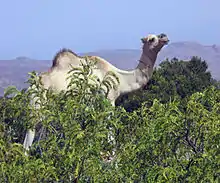
Birds
Somaliland is currently home to about 727 bird species, of which eight are endemic, one has been introduced by humans and one is rare or accidental. Fourteen species are globally threatened. The following species of birds are found exclusively in Somaliland:[4]
- (Qoolay) Red-eyed dove (Streptopelia semitorquata)
- (Xamaam) Speckled Pigeon (Columba guinea guinea)
- White-backed vulture (Gyps africanus)
- Namaqua Dove (Oena capensis capensis)
- Somali Bulbul (Pycnonotus barbatus somaliensis)
- Somali Pigeon
- Black boubou
- Alaemon hamertoni (Alaudidae) - Lesser Hoopoe-Lark
- Heteromirafra archeri (Alaudidae) - Archer's Lark
- Mirafra ashi - Ash's Bushlark
- Mirafra somalica (Alaudidae) - Somali Bushlark
- Carduelis johannis (Fringillidae) - Warsangli Linnet
Reptiles
Somaliland has roughly 235 species of reptiles
There is reptiles unique to Somaliland include Hughes' saw-scaled viper, Boomslang, Black Mamba, Yellow-bellied sea snake, Egyptian Cobra, Red Spitting Cobra, Somali puff adder, Somali carpet viper,Platyceps messanai, Scortecci's diadem snake Spalerosophis josephscorteccii, the Somali sand boa, the angled worm lizard, Macfadyen's mastigure Uromastyx macfadyeni, Lanza's gecko Hemidactylus granchii, the semaphore gecko, and a wall lizard from either Mesalina or Eremias. The colubrid snake Aprosdoketophis andreonei and Haacke-Greer's skink Haackgreerius miopus are endemic genera.[5]
Fish
With 740 km of coastline facing the Red Sea. Somaliland waters are prime fishing grounds for highly migratory fish species such as tuna and tuna-like species, and a narrow but productive continental shelf is the home to several demersal fish and crustacean species.[6]
Fish species found exclusively in Somaliland include:
Flora
The highlands, which in an almost continuous line traverse East Africa, have to a great extent isolated the flora of Somaliland in spite of the general resemblance of its climate and soil to the country on the western side of the band of high ground. The greater part of the country is covered either with tall coarse grasses, or more commonly with thick thorn-bush or jungle, among which rise occasional isolated, trees. The prevalent bush plants are khansa, acacias, aloes, and, especially, Boswellia and Commiphora, which yield highly fragrant resins and balsams, such as myrrh, frankincense (olibanum) and balm of Gilead.
Among the larger trees are the mountain cedar, reaching to 100 ft.; the gob, which bears edible berries in appearance something like the cherry with the taste of an apple, grows to some 80 ft. There are patches of dense reeds, reaching 10 ft. high, and thickets of tamarisk along the river beds, and on either side the jungle is high and more luxuriant than on the open plateau. Of herbaceous plants the kissenia, the sole representative of the order Loasaceae, ‘which is common in America but very rare elsewhere, is found in Somaliland, which also possesses forms belonging to the eastern Mediterranean flora.
The following vascular plant genera are found exclusively in Somaliland:[7]
- Boswellia occulta (Burseraceae) The new species Boswellia occulta is described from a small area in the El Afweyn District of Somaliland, where it is locally of considerable socio-economic importance. Although used for frankincense production by many generations of local harvesters, it has been unknown to science until now.
- (‘Gagabood’) Iphiona rotundifolia
- (‘Dibow’) Euphorbia inculta
- (‘Sobkax’) Odontanthera radians a member of the family Apocynaceae, which is found in the coastal and subcoastal areas of Somaliland.
- (‘Kulan’) Balanites rotundifolia
- (‘Maygaag’) Boscia miminifolia
- ('Qudhac') Vachellia tortilis
- Eriostylos 1 spp. Amaranthaceae
- Polyrhabda 1 spp. Amaranthaceae
- Goydera 1 spp. Apocynaceae
- Whitesloanea 1 spp. Apocynaceae
- Puccionia 1 spp. Cleomaceae
- Afrotrichloris 2 spp. Gramineae
- Pseudozoysia 1 spp. Gramineae
- Taeniorhachis 1 spp. Gramineae
- Renschia 1 spp. Labiatae
- Symphyochlamys 1 spp. Malvaceae
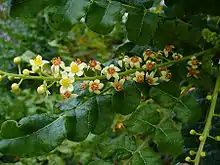
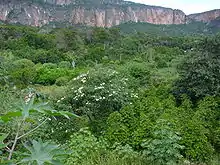
National animals

- National animal: Kudu
Notes
- Puglielli, Annarita, and Cabdallah Cumar Mansuur. "Grammatica della lingua somala per le scuole superiori." (2013).
- Bauer, H.; Packer, C.; Funston, P.F.; Henschel, P.; Nowell, K. (2016). "Panthera leo". IUCN Red List of Threatened Species. 2016: e.T15951A115130419. doi:10.2305/IUCN.UK.2016-3.RLTS.T15951A107265605.en. Retrieved 15 January 2018.{{cite iucn}}: error: |doi= / |page= mismatch (help)
- Wilson, D.E. & Reeder, D.M. (Eds.) (2005). Mammal Species of the World: A Taxonomic and Geographic Reference. Third Edition. The Johns Hopkins University Press, Baltimore.
- Dickinson, E.C. (Ed.)(2003) The Howard and Moore Complete Checklist of the Birds of the World. Revised and enlarged third edition. Princeton University Press, Princeton.
- Uetz, P. & Jirí Hošek (eds.), The Reptile Database, htUetz, P. & Jirí Hošek (e Uetz, P. & Jirí Hošek (eds.), The Reptile Database, http://www.reptile-database.org, accessed Dec 8, 2013
- FishBase 2004: a global information system on fishes. DVD. WorldFish Center - Philippine Office, Los Banos, Philippines. Published in May 2004
- Mabberley, D.J. (2008) Mabberley's Plant-book. Third Edition. Cambridge University Press, Cambridge.
References
- Mazuch, Tomas (ed.). Venomous Snakes in Somaliland.
- Wilson, Don E.; Reeder, DeeAnn M., eds. (2005). Mammal Species of the World: A Taxonomic and Geographic Reference (3rd ed). Johns Hopkins University Press. Retrieved 3 August 2009.
- http://somalilandbiodiversity.org. Missing or empty
|title=(help) - {{|url=https://www.biotaxa.org/Phytotaxa/article/view/phytotaxa.394.3.3
|url=http://animaldiversity.ummz.umich.edu/site/index.html |title=Animal Diversity Web |publisher=University of Michigan Museum of Zoology |date=1995–2006 |accessdate=22 May 2007}}
